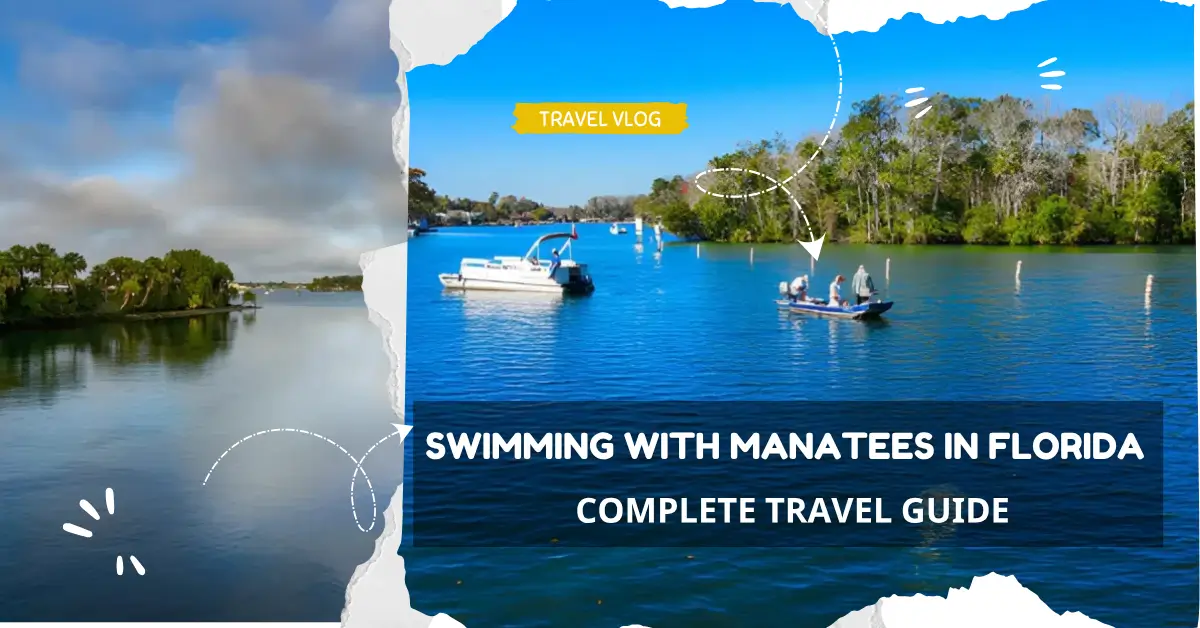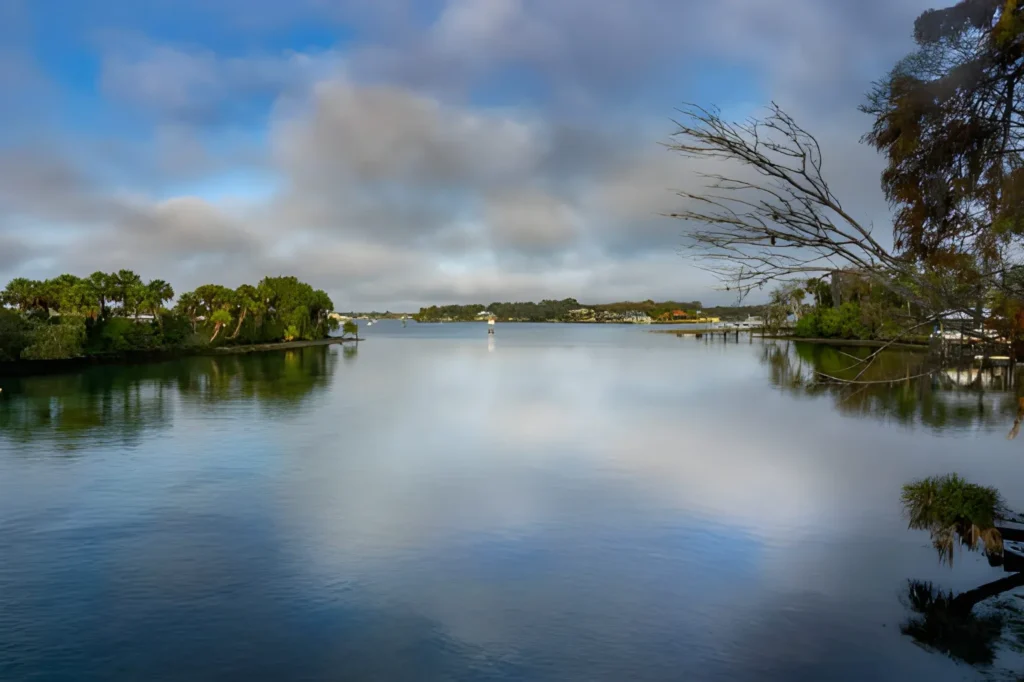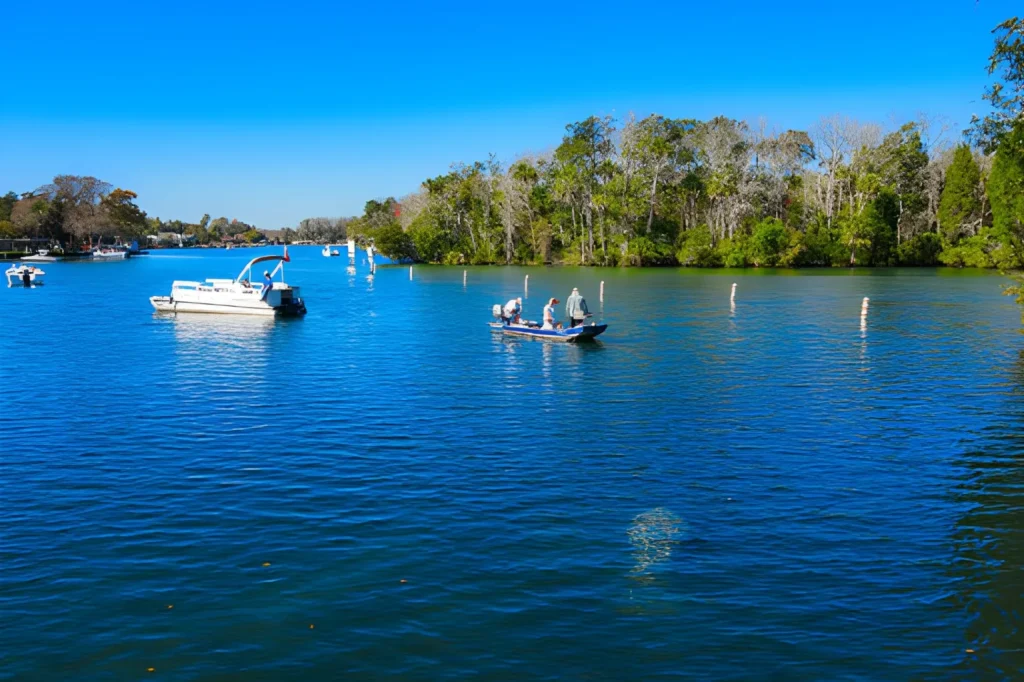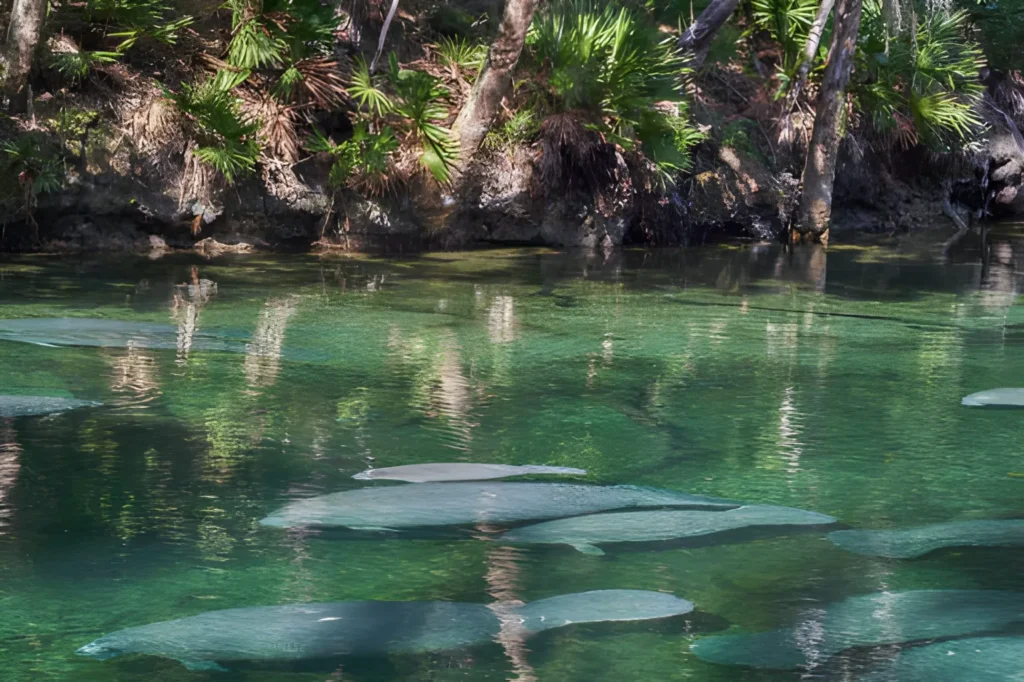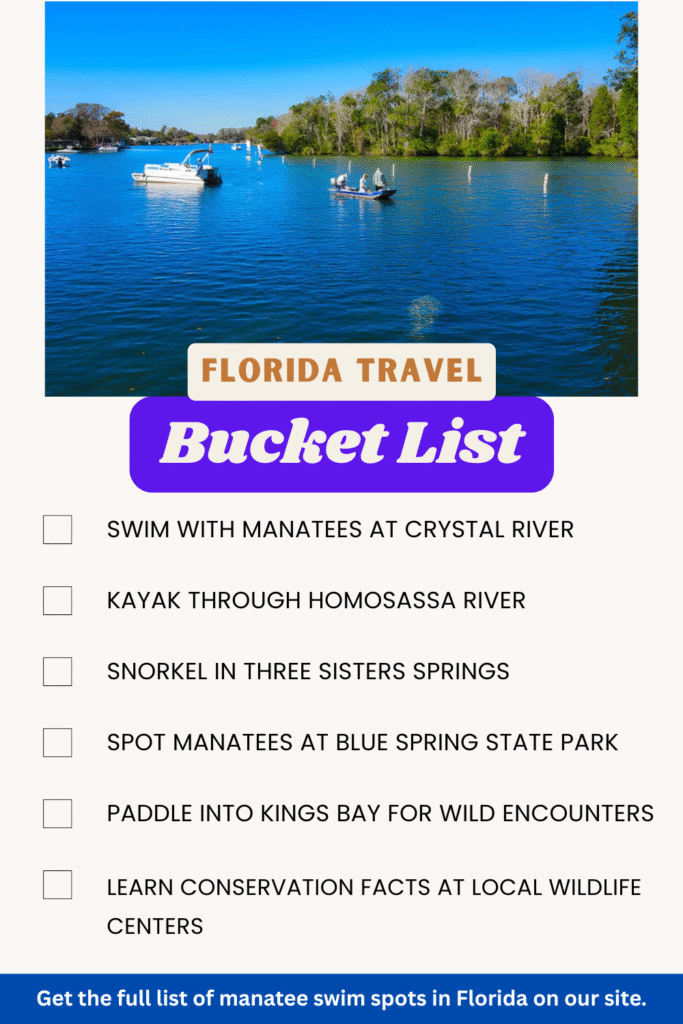Few wildlife encounters are as magical as floating quietly beside a manatee. Known as gentle giants of the sea, these creatures glide through Florida’s freshwater springs and coastal rivers with an elegance that seems at odds with their size. My first swim with manatees in Crystal River felt like stepping into another world — hearing only my own breath through a snorkel, while a curious manatee drifted close enough to inspect me with its whiskered snout.
Florida is the only place in North America where you can legally swim with manatees in the wild. If you’re planning a trip in 2025, knowing where to go, when to visit, and how to behave responsibly will transform this from a simple tour into an unforgettable memory.
Understanding Manatees Before You Swim
Definition list of key facts
Species in Florida
West Indian manatees, specifically the Florida subspecies, are found in rivers, estuaries, and coastal waters.
Size and Weight
Adults average 10–12 feet long and weigh up to 1,300 pounds, yet they are slow-moving and non-aggressive.
Diet
They are herbivores, grazing on seagrass and aquatic plants for up to 8 hours a day.
Lifespan
Wild manatees can live 50–60 years when protected from human threats.
Behavior
Manatees are naturally curious. If you float calmly, they may approach you — but interactions must always remain passive.
Why Florida Is the Best Place to Swim with Manatees
When the Gulf of Mexico cools in winter, hundreds of manatees migrate inland to Florida’s warm, spring-fed waters. These springs remain a constant 72°F year-round, making them safe havens for manatees — and excellent places for travelers to observe them up close.
Unlike aquariums or staged encounters, Florida offers authentic wild experiences. You’re entering their world, not the other way around. And that makes proper planning and respect even more important.
Ethics of Swimming with Manatees
One of the biggest gaps in many guides is a lack of detail on ethics and regulations. From my tours, I learned quickly that swimming with manatees is a privilege, not a right. The U.S. Fish and Wildlife Service enforces strict rules to protect these threatened animals.
Rules you must follow
- Float on the surface; never dive onto a manatee.
- Do not chase, corner, or separate a calf from its mother.
- Do not feed or touch them — even if they brush against you.
- Stay quiet and calm; loud noises stress them.
- Obey sanctuary signs; some areas are off-limits.
Traveler insight
On my first swim, a young manatee approached and nibbled gently at my wetsuit strap. While it was tempting to reach out, our guide reminded us: “If they choose contact, it’s their choice — not yours.” That moment taught me that patience always rewards the respectful swimmer.
Best Places in Florida to Swim with Manatees
Most visitors know about Crystal River, but several regions in Florida offer manatee encounters. Adding variety ensures travelers can choose based on convenience and crowds.
Crystal River and Kings Bay
Crystal River is the undisputed Manatee Capital of the World. In peak season, more than 600 manatees gather here. On my December trip, I counted dozens in just one cove of Three Sisters Springs.
Highlights
- Three Sisters Springs: Clear water and multiple viewing platforms.
- King Spring: A protected sanctuary where manatees cluster in cold snaps.
- Hunter Springs Park: A family-friendly public swimming and kayak area where manatees often pass by.
Traveler guide
- Book a licensed tour; it’s the safest and most reliable way to see manatees.
- Early morning tours (6–7 a.m.) are best for active manatees and fewer crowds.
- Even outside peak winter, resident manatees remain year-round.
Homosassa River
Just south of Crystal River, Homosassa offers a quieter experience. At Homosassa Springs Wildlife State Park, I saw manatees in rehabilitation pools as well as in the wild river system.
Why visit here
- Smaller crowds than Crystal River.
- Chance to combine swimming with park-based viewing.
- Educational talks by rangers explain manatee conservation.
Blue Spring State Park
Located near Orlando, Blue Spring is a winter refuge for hundreds of manatees. While swimming is not allowed inside the spring run during manatee season, you can kayak just outside the protected area and watch herds gather from the boardwalk.
Traveler tip
If you’re already visiting Orlando, this is the easiest place to see manatees without a long drive. Arrive early; parking often fills by 9 a.m. in winter.
Data Table: Best Manatee Viewing and Swimming Locations
| Location | Region | Swim Allowed | Peak Season | Why It’s Great |
|---|---|---|---|---|
| Crystal River / Kings Bay | Central Gulf Coast | Yes | Nov–Mar | Largest wild manatee population |
| Homosassa River | Central Gulf Coast | Yes | Nov–Mar | Fewer crowds, combines with wildlife park |
| Blue Spring State Park | Central Florida | Limited (kayak nearby) | Dec–Feb | Easy Orlando access, boardwalk views |
| Hunter Springs Park | Crystal River town | Yes | Year-round | Family-friendly public swim area |
Best Time to Swim with Manatees in Florida
Timing makes all the difference. Over several visits, I noticed how both the season and the time of day shaped the experience.
Seasonal Guide
- Winter (Nov–Mar): Hundreds of manatees gather in springs when Gulf waters cool. Ideal for guaranteed sightings, though it can be crowded.
- Spring (Apr–Jun): Fewer tourists, and manatees are more active while grazing. I swam in May and shared the water with about 20 manatees — plenty for a private-feeling experience.
- Summer (Jul–Sep): Resident manatees remain, but sightings are fewer. Heat and afternoon storms can make conditions tricky.
- Fall (Oct): A shoulder season with mild weather and occasional manatee encounters.
Best time of day
- Early mornings (6–8 a.m.) are ideal. Manatees are active, visibility is clearer, and tours are less crowded.
- Midday brings larger groups of boats, while late afternoons see reduced activity.
When Not to Swim with Manatees
Crowds and conditions can affect both you and the manatees.
- ● Peak holiday weeks like Christmas and New Year see congested waters. On one December visit, I saw 30 snorkelers huddled around a single manatee — not enjoyable for anyone.
- ● Cold fronts in winter can make swimming uncomfortable, especially for kids. Even with wetsuits, my daughter shivered after 15 minutes.
- ● Stormy summer days often stir up sediment, reducing visibility.
Traveler tip: If your schedule is flexible, book on weekdays and avoid major holidays.
What Manatee Tours Typically Include
Most operators follow a similar routine, but quality varies. From my experiences across different tours, here’s what to expect:
What’s Included
- Wetsuit (for warmth and buoyancy)
- Snorkel and mask
- Pool noodle or flotation device
- Safety and wildlife etiquette briefing
- Boat ride to and from the springs
- Hot drinks on cooler days
Optional extras
- Underwater photography packages (worth it — guides know how to capture the best angles).
- Private or semi-private tours for smaller groups.
Traveler insight
Some tours also provide reusable cups, reef-safe sunscreen, and eco-education talks. Choose operators who emphasize conservation, not just sightseeing.
Cost of Swimming with Manatees
Prices vary depending on group size and extras.
- Group tours: $60–$75 per snorkeler (8–12 participants).
- Semi-private tours: $90–$110 per snorkeler (4–6 participants).
- Private tours: $400–$600 per boat, often for families or photographers.
- Rider-only tickets: $40–$50 if you’d prefer to stay on the boat.
Photography packages average $25–$40. On one trip, I purchased a $30 photo set — and the guide’s GoPro shots were far better than mine.
What It’s Really Like to Swim with Manatees
Photos often show crystal-clear blue water, but conditions vary.
- Visibility: Some springs, like Three Sisters, are strikingly clear. Others, like King’s Bay, can be slightly murky but still good enough to spot manatees grazing.
- The Encounter: Manatees are enormous (up to 1,300 lbs), but they move slowly and gently. One glided so close that its whiskers brushed my arm — a humbling reminder that they are curious but fragile.
- Safety: Manatees are harmless herbivores. The real danger comes from ignoring rules or startling them. Guides stress calm, quiet floating — which enhances the experience anyway.
Traveler tip: Don’t expect to swim fast or chase them. Floating quietly is the magic — they’ll approach you when comfortable.
Family Tips for Manatee Tours
Bringing kids changes the dynamic, and not all guides explain this clearly.
- Minimum age is usually 3 years old, though many recommend 6+.
- Kids who can float quietly with a snorkel have the best experience.
- For younger ones, consider booking them as boat riders instead of snorkelers.
- Water temperature in winter (72°F) feels chilly. My 8-year-old lasted only 10 minutes before heading back to the boat.
Traveler insight: If your kids are nervous in dark water, practice snorkeling in a pool first. It builds confidence before the real encounter.
Data Table: Manatee Tour Essentials
| Category | Details | Insider Tip |
|---|---|---|
| Best Season | Nov–Mar | Book early for holidays, but consider spring for fewer crowds |
| Best Time of Day | 6–8 a.m. | Manatees are most active and tours are less busy |
| Tour Inclusions | Wetsuit, snorkel, mask, flotation, briefing | Bring your own quick-dry towel |
| Average Cost | $65–$110 per snorkeler | Photography packages often worth the extra |
| Family-Friendly? | Yes, ages 3+ | Kids may prefer boat rider tickets |
Can You See Manatees Without a Tour?
Yes — but opportunities are limited, and knowing the legal access points is essential. On my self-guided visits, I found it rewarding but less reliable than tours.
Public Access Spots
- Hunter Springs Park: Family-friendly with a small swimming beach. I spotted two manatees here while wading waist-deep.
- Kings Bay Park: Offers a kayak launch and playground; I paddled out and had a chance encounter with a lone manatee near the docks.
- Three Sisters Springs (via kayak): You can paddle into this spring run, but swimming directly from the boardwalk isn’t allowed. Seasonal closures also apply.
Traveler tip: Self-guided visits are better for repeat travelers or locals. First-time visitors get more from guided tours, where spotting manatees is almost guaranteed.
What to Pack for a Manatee Swim
Even if your tour provides gear, a few extras make the day smoother.
- ● Reef-safe sunscreen (protects water quality)
- ● Quick-dry towel (boats don’t always have spares)
- ● Dry bag (for phones, snacks, and clothes)
- ● Rash guard or swim shirt (for sun protection after your tour)
- ● Water shoes or sandals (for docks and rocky spots)
- ● GoPro or waterproof camera (guides take photos, but capturing your own is priceless)
- ● Motion sickness tablets if you’re sensitive to boats
Manatee Conservation Facts Every Traveler Should Know
Manatees are a threatened species, and your swim helps only if done responsibly. Here are some key things I learned from guides and wildlife centers:
- Manatees can hold their breath for up to 20 minutes, but they usually surface every 2–5 minutes.
- Despite their size, their brains are small relative to their bodies — about the size of a grapefruit.
- Manatees have no natural predators, but boat strikes, habitat loss, and pollution remain serious threats.
- Conservation programs in Florida include seagrass restoration and rescue/rehabilitation centers at places like Homosassa Springs.
Traveler insight: Your tour fee often supports conservation — another reason to choose licensed operators.
Other Things to Do Near Crystal River
If you’re already in the area, extend your trip with activities that complement the manatee experience.
- Paddle into Rainbow Springs: Crystal-clear water with snorkeling, tubing, and kayak rentals.
- Homosassa Springs Wildlife State Park: View manatees in rehab and learn about native wildlife.
- Scalloping in Summer: A fun alternative from July–September — like an underwater treasure hunt.
- Weeki Wachee Springs: Famous for mermaid shows and a family-friendly water park.
- Historic Downtown Crystal River: Murals, boutique shops, and seafood restaurants make for a relaxed afternoon.
Final Tips for a Perfect Manatee Encounter
- ● Book tours in advance, especially for early mornings.
- ● Visit in spring for fewer crowds, but expect smaller groups of manatees.
- ● Float quietly — the less you move, the more curious manatees become.
- ● Bring flexibility in your schedule; weather may delay or reschedule tours.
- ● Remember: it’s about observing, not touching — patience brings the most authentic encounters.
Conclusion
Swimming with manatees in Florida is more than a tourist activity — it’s a chance to connect with one of the ocean’s most gentle and endangered species. Whether you join a sunrise tour in Crystal River, kayak through the Homosassa River, or simply watch from a boardwalk at Blue Spring, the experience leaves you humbled and inspired.
If you’re planning your Florida trip in 2025, put manatees at the top of your list. Respect the rules, choose ethical operators, and savor every quiet moment drifting beside these sea cows. It’s a memory that stays long after the water dries.

